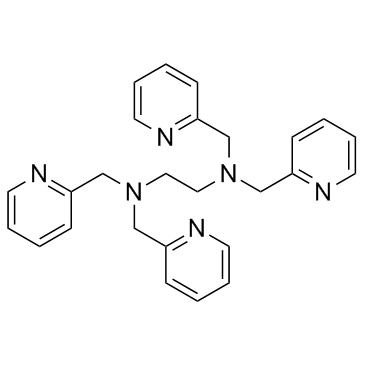TPEN

TPEN structure
|
Common Name | TPEN | ||
|---|---|---|---|---|
| CAS Number | 16858-02-9 | Molecular Weight | 424.541 | |
| Density | 1.2±0.1 g/cm3 | Boiling Point | 542.1±45.0 °C at 760 mmHg | |
| Molecular Formula | C26H28N6 | Melting Point | 110-112 °C | |
| MSDS | Chinese USA | Flash Point | 281.7±28.7 °C | |
| Symbol |

GHS07 |
Signal Word | Warning | |
|
Redistribution of subcellular calcium and its effect on apoptosis in primary cultures of rat proximal tubular cells exposed to lead.
Toxicology 333 , 137-46, (2015) Previous studies have shown that cytosolic Ca(2+) ([Ca(2+)]c) overload was involved in Pb-induced apoptosis in primary cultures of rat proximal tubular (rPT) cells, but the source of elevated Ca(2+) and the effect of potential subcellular Ca(2+) redistributio... |
|
|
Rat pancreatitis produced by 13-week administration of zinc oxide nanoparticles: biopersistence of nanoparticles and possible solutions.
J. Appl. Toxicol. 33(10) , 1089-96, (2013) Zinc oxide (ZnO) nanoparticles (NPs) are used in diverse applications ranging from paints and cosmetics to biomedicine and food. Although micron-sized ZnO is a traditional food supplement, ZnO NPs are an unknown public health risk because of their unique phys... |
|
|
Zinc is released by cultured astrocytes as a gliotransmitter under hypoosmotic stress-loaded conditions and regulates microglial activity.
Life Sci. 94(2) , 137-44, (2014) Astrocytes contribute to the maintenance of brain homeostasis via the release of gliotransmitters such as ATP and glutamate. Here we examined whether zinc was released from astrocytes under stress-loaded conditions, and was involved in the regulation of micro... |
|
|
Potential interactions of calcium-sensitive reagents with zinc ion in different cultured cells.
PLoS ONE 10 , e0127421, (2015) Several chemicals have been widely used to evaluate the involvement of free Ca(2+) in mechanisms underlying a variety of biological responses for decades. Here, we report high reactivity to zinc of well-known Ca(2+)-sensitive reagents in diverse cultured cell... |
|
|
Zinc deficiency mediates alcohol-induced apoptotic cell death in the liver of rats through activating ER and mitochondrial cell death pathways.
Am. J. Physiol. Gastrointest. Liver Physiol. 308 , G757-66, (2015) Hepatic zinc deficiency has been well documented in alcoholic patients, but the mechanisms by which zinc deficiency mediates cell death have not been well defined. The objectives of this study were to determine whether alcohol perturbs subcellular zinc homeos... |
|
|
Trans-synaptic zinc mobilization improves social interaction in two mouse models of autism through NMDAR activation.
Nat. Commun. 6 , 7168, (2015) Genetic aspects of autism spectrum disorders (ASDs) have recently been extensively explored, but environmental influences that affect ASDs have received considerably less attention. Zinc (Zn) is a nutritional factor implicated in ASDs, but evidence for a stro... |
|
|
Effect of zinc supplements in the attenuated cardioprotective effect of ischemic preconditioning in hyperlipidemic rat heart.
Naunyn Schmiedebergs Arch. Pharmacol. 388 , 635-41, (2015) Hyperlipidemia is regarded as independent risk factor in the development of ischemic heart disease, and it can increase the myocardial susceptibility to ischemia-/reperfusion (I/R)-induced injury. Hyperlipidemia attenuates the cardioprotective response of isc... |
|
|
Hypoxia lowers SLC30A8/ZnT8 expression and free cytosolic Zn2+ in pancreatic beta cells.
Diabetologia 57(8) , 1635-44, (2014) Hypoxic damage complicates islet isolation for transplantation and may contribute to beta cell failure in type 2 diabetes. Polymorphisms in the SLC30A8 gene, encoding the secretory granule zinc transporter 8 (ZnT8), influence type 2 diabetes risk, conceivably... |
|
|
TPEN prevents rapid pacing-induced calcium overload and nitration stress in HL-1 myocytes.
Cardiovasc. Ther. 33 , 200-8, (2015) Atrial fibrillation (AF) is the most common cardiac arrhythmia. However, the current drug interference of antiarrhythmia has limited efficacy and off-target effects. Accumulating evidence has implicated a potential role of nitration stress in the pathogenesis... |
|
|
Vibrio vulnificus Secretes an Insulin-degrading Enzyme That Promotes Bacterial Proliferation in Vivo.
J. Biol. Chem. 290 , 18708-20, (2015) We describe a novel insulin-degrading enzyme, SidC, that contributes to the proliferation of the human bacterial pathogen Vibrio vulnificus in a mouse model. SidC is phylogenetically distinct from other known insulin-degrading enzymes and is expressed and sec... |